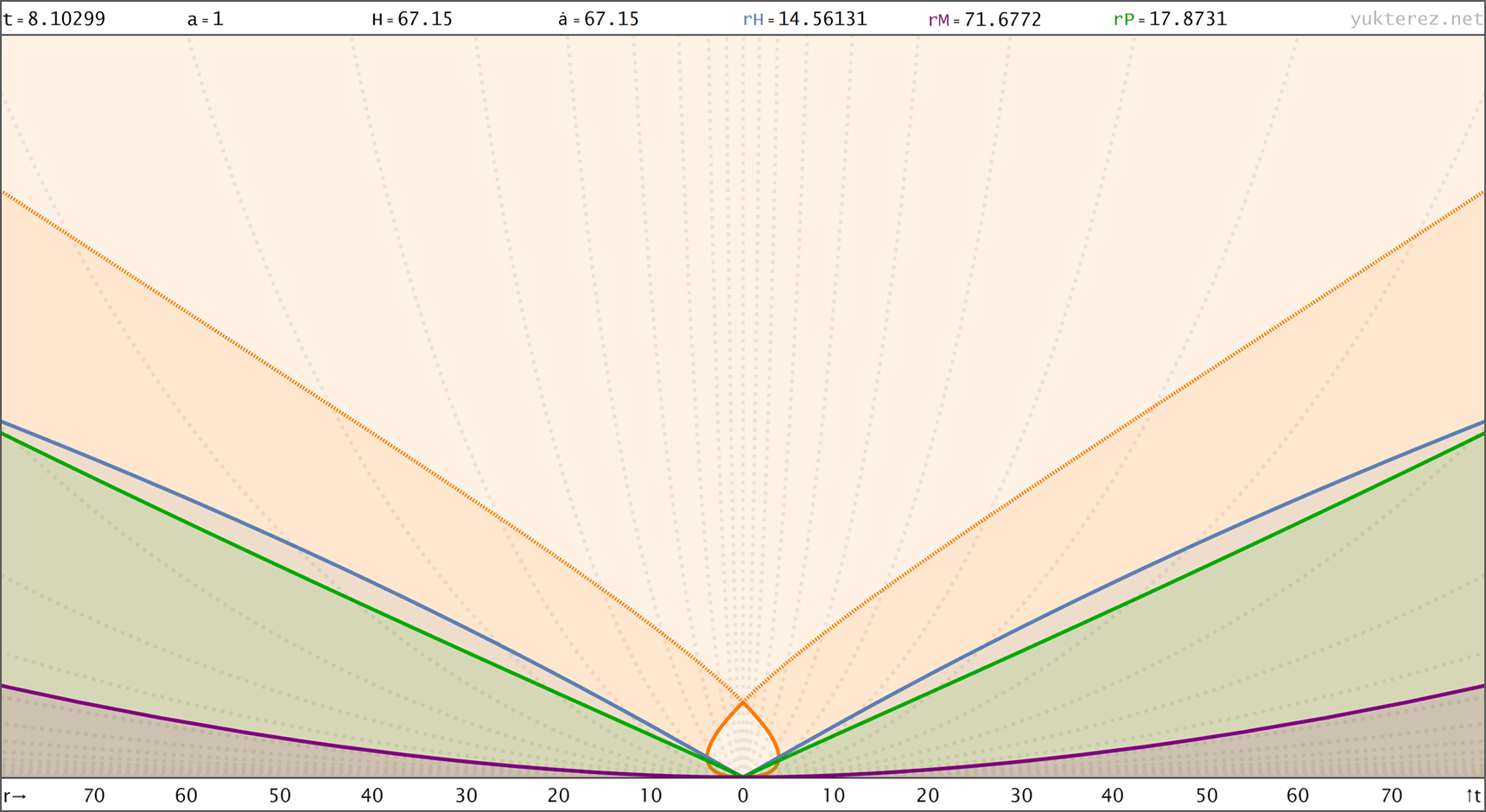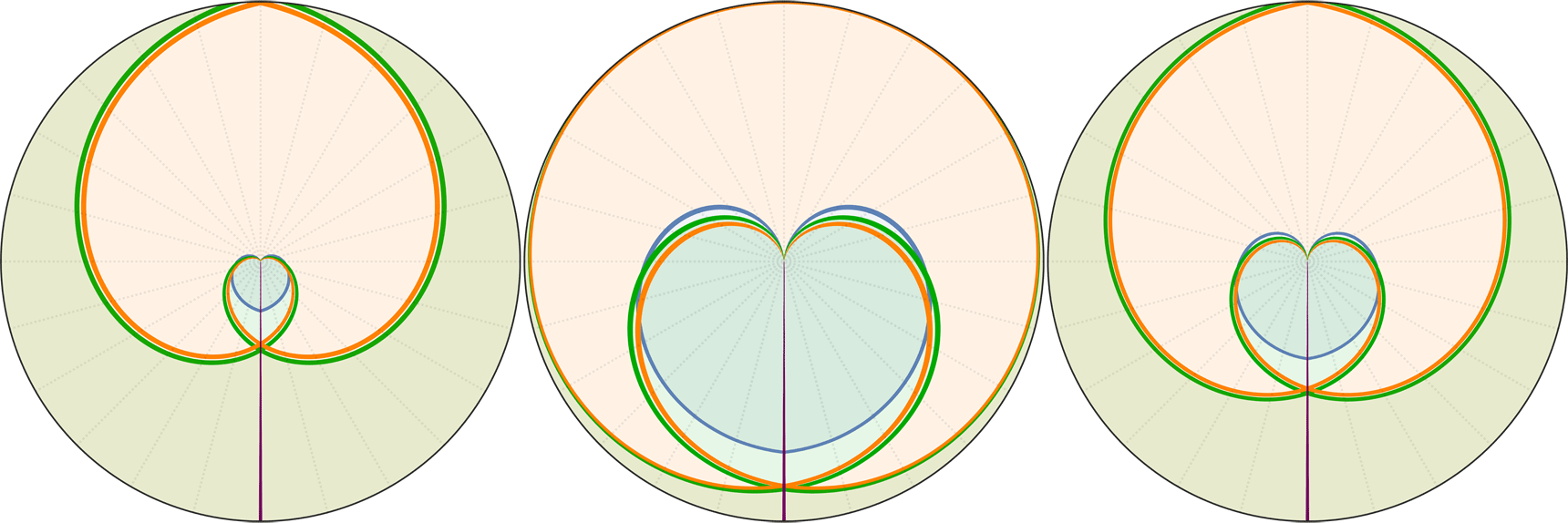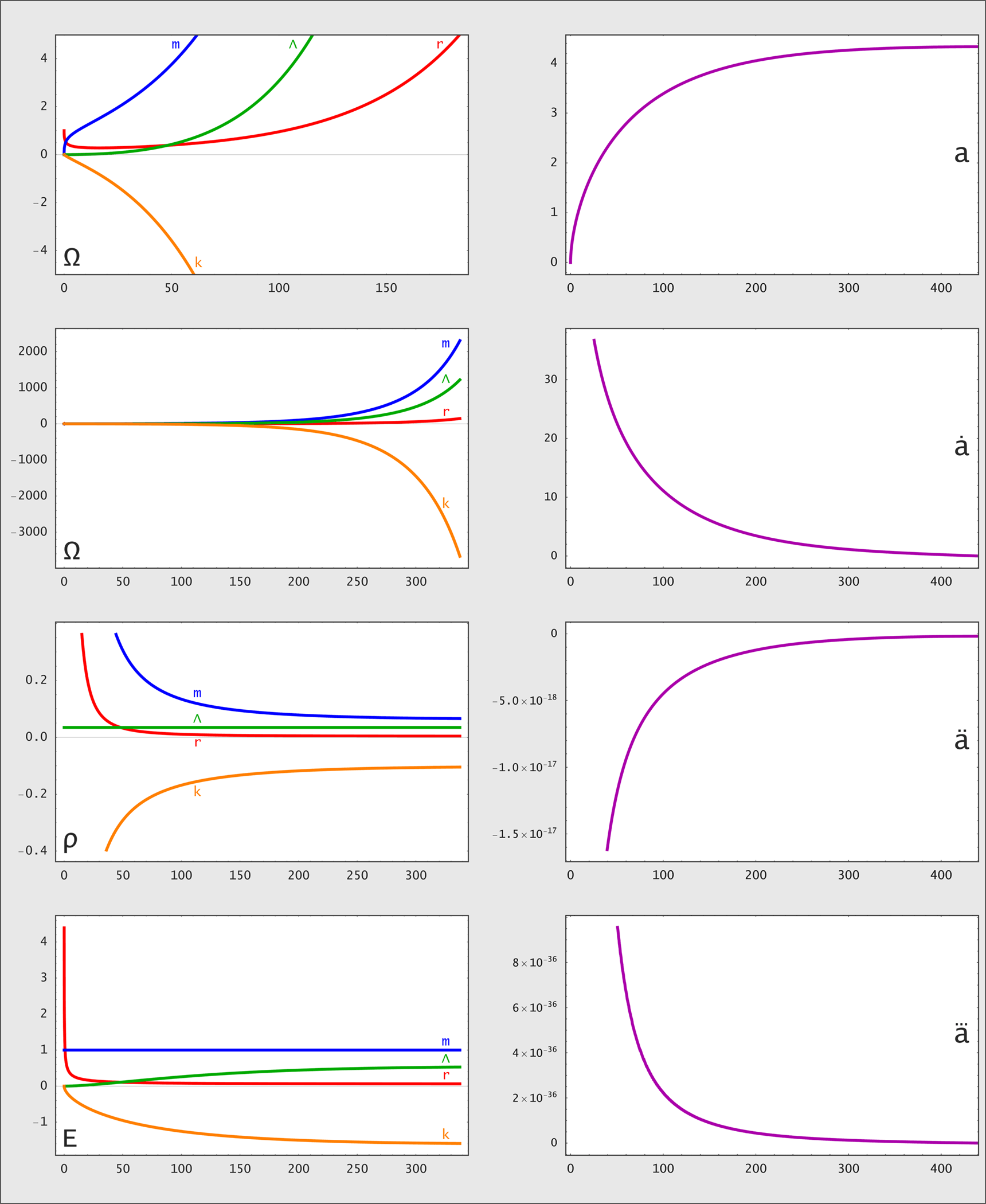
 Das ist die deutschsprachige Version.
Das ist die deutschsprachige Version.  For the english version see here.
For the english version see here. 



Kritischer Wert für die dunkle Energie ΩΛ in einem geschlossenen Universum; ein geringerer Wert führt zu einem Big Crunch, der exakte Wert zu einem Stillstand und ein höherer Wert sorgt dafür dass der Hubbleparameter H nie 0 wird und letztendlich auf einen konstanten Wert zukonvergiert, also eine beschleunigte Expansion:
Anwendungsbeispiel: Bei In[1] wird der normalisierte Hubbleparameter H und die erste und zweite Zeitableitung (ȧ und ä) des normalisierten Skalenfaktors a sowie die Zusammenhänge zwischen Druck, Dichte und Krümmung definiert. Bei In[5] wird die Geschwindigkeit und Beschleunigung der Expansion auf 0 gesetzt um nach dem Grenzwert zwischen Expansion und Kontraktion aufzulösen (auch alle anderen Zeitableitungen von a werden dort 0). Bei In[6] werden die gewünschten Werte für die Materie Ωm und die Strahlung Ωr festgelegt. Bei In/Out[8] wird das für den Grenzfall benötigte ΩΛ und der Skalenfaktor bei dem das unstabile Gleichgewicht eintritt ausgegeben, was zur Probe bei Out[11] nochmal geplottet wird. Die Plotwerte nach der vertikalen Hilfslinie gehören zu solchen a Werten die zu keinem vorhersehbaren Zeitpunkt t erreicht werden da beim maximalen a von hier a=4.33407 sowohl H=0 als auch dH/dt=0, also ein unstabiles Gleichgewicht erreicht wird:

Raumzeitdiagamme des oberen Universums in Proper Distance r(t), Comoving Distance R(t) & nach Conformal Time R(η) Koordinaten. rH: Hubble Radius (blau), rE: Ereignishorizont (keiner), rP: Partikelhorizont (grün), rM: Antipode πrK (violett), orange Kurve: Lichtkegel, graue Kurven: mitbewegte Weltlinien, R=r/a:








Die Metrik in radiusgetreuen und umfanggetreuen Koordinaten findet sich in dieser Liste. Da hier oben die radialen Abstände eingezeichnet sind wurden Erstere verwendet.
Code: Alles auswählen
(* | Solver for the critical value of ΩΛ in a closed universe || yukterez.net | *)
Ωk = 1-Ωm-Ωr-ΩΛ;
pr = Ωr/3;
pm = 0;
H² = Ωr/a^4+Ωm/a^3+Ωk/a^2+ΩΛ;
ȧ² = H² a^2;
ä = a (ΩΛ-(Ωm+pm)/a^3/2-(Ωr+pr)/a^4/2);
Ωr = 3/10;
Ωm = 11/10;
f = Reduce[ȧ²==ä==0 && Ωr+Ωm+ΩΛ>1 && Ωr>=0 && Ωm>=0 && ΩΛ>0 && a>1, ΩΛ]
A = N[f[[1,2]]]
ΩΛ = N[f[[2,2]]]/.a->A
plot[x_]:=Plot[x, {a, A-1, A+1}, Frame -> True, GridLines -> {{A}, {}}]
"H²"->plot[H²]
"ȧ²"->plot[ȧ²]
"ä"->plot[ä]
Quit[]Anwendungsbeispiel: Bei In[1] wird der normalisierte Hubbleparameter H und die erste und zweite Zeitableitung (ȧ und ä) des normalisierten Skalenfaktors a sowie die Zusammenhänge zwischen Druck, Dichte und Krümmung definiert. Bei In[5] wird die Geschwindigkeit und Beschleunigung der Expansion auf 0 gesetzt um nach dem Grenzwert zwischen Expansion und Kontraktion aufzulösen (auch alle anderen Zeitableitungen von a werden dort 0). Bei In[6] werden die gewünschten Werte für die Materie Ωm und die Strahlung Ωr festgelegt. Bei In/Out[8] wird das für den Grenzfall benötigte ΩΛ und der Skalenfaktor bei dem das unstabile Gleichgewicht eintritt ausgegeben, was zur Probe bei Out[11] nochmal geplottet wird. Die Plotwerte nach der vertikalen Hilfslinie gehören zu solchen a Werten die zu keinem vorhersehbaren Zeitpunkt t erreicht werden da beim maximalen a von hier a=4.33407 sowohl H=0 als auch dH/dt=0, also ein unstabiles Gleichgewicht erreicht wird:

Raumzeitdiagamme des oberen Universums in Proper Distance r(t), Comoving Distance R(t) & nach Conformal Time R(η) Koordinaten. rH: Hubble Radius (blau), rE: Ereignishorizont (keiner), rP: Partikelhorizont (grün), rM: Antipode πrK (violett), orange Kurve: Lichtkegel, graue Kurven: mitbewegte Weltlinien, R=r/a:

↑ proper, r(t) ◉ ↓ comoving, R(t)

↑ comoving, R(t) ◉ ↓ conformal, R(η)

↑ t = 8.1 Gyr, a = 1 ◉ ↓ t = 440.1 Gyr, a = 4.334

↑ proper, r(t) ◉ ↓ comoving, R(t)

↑ comoving, R(t) ◉ ↓ conformal, R(η)

↑ conformal, R(η) ◉ ↓ polar, R(t)→φ(Я) & R(a)→φ(Я) & R(η)→φ(Я)

↑ Raumzeitdiagramme ◉ ↓ Ω, ρ, E, a, ȧ, ä als Funktionen von t

Die Metrik in radiusgetreuen und umfanggetreuen Koordinaten findet sich in dieser Liste. Da hier oben die radialen Abstände eingezeichnet sind wurden Erstere verwendet.
Code: Alles auswählen
(* | Evolution of a closed FLRW Universe that reaches an unstable equilibrium | *)
set = {"GlobalAdaptive", "MaxErrorIncreases"->100,
Method->"GaussKronrodRule"}; (* Integration Rule *)
n = 100; (* Recursion Depth *)
int[f_, {x_, xmin_, xmax_}] := (* Integral *)
NIntegrate[f, {x, xmin, xmax},
Method->set, MaxRecursion->n, WorkingPrecision->wp];
wp = MachinePrecision; (* Working Precision *)
im = 200; (* Image Size *)
ηmax = 800; pmax = 800; (* Plot Range *)
amax = Root[4+11#-10#^2-33#^3+8#^4&, 2, 0]; (* Maximal Scale Factor *)
tmax = 444 Gyr; (* Integration Limit *)
c = 299792458 m/sek; (* Lightspeed *)
G = 667384*^-16 m^3 kg^-1 sek^-2; (* Newton Constant *)
Gyr = 10^7*36525*24*3600 sek; (* Billion Years *)
Glyr = Gyr*c; (* Billion Lightyears *)
Mpc = 30856775777948584200000 m; (* Megaparsec *)
ρc[H_] := 3H^2/8/π/G; (* Critical Density *)
ρΛ = ρc[H0] ΩΛ; (* Dark Energy Density *)
kg = m = sek = 1; (* SI Units *)
ΩR = 3/10; (* Radiation Proportion including Neutrinos *)
ΩM = 11/10; (* Matter Proportion including Dark Matter *)
ΩΛ = 3/32+(77 Root[4+11#-10#^2-33#^3+8#^4&, 2, 0])/16+
(203 Root[4+11#-10#^2-33#^3+8#^4&, 2, 0]^2)/160-
(11 Root[4+11#-10#^2-33#^3+8#^4&, 2, 0]^3)/20; (* Dark Energy Proportion *)
ΩT = ΩR+ΩM+ΩΛ; (* Total Density over Critical Density *)
ΩK = 1-ΩT; (* Curvature Density *)
rK = c/H0/Sqrt[-ΩK]; (* Curvature Radius *)
H0 = 67150 m/Mpc/sek; (* Hubble Constant *)
H[a_] := H0 Sqrt[ΩR/a^4+ΩM/a^3+ΩK/a^2+ΩΛ] (* Hubble Parameter *)
sol = Quiet[NDSolve[{A'[t]/A[t] == H[A[t]], A[0] == 1*^-15,
WhenEvent[Abs[A[t]] == amax, tMax=t; "StopIntegration"]},
A, {t, 0, tmax},
MaxSteps->∞, WorkingPrecision->wp]];
â[t_] := Evaluate[(A[t]/.sol)[[1]]]; (* Scale Factor a by Time t *)
a[t_] := If[t<tmax, â[t], amax]; If[t>tmax, amax, â[t]]; (* Optimized a of t *)
т[a_] := int[1/A/H[A], {A, 0, a}]; (* Time t by Scale Factor a *)
rP[t_] := a[t] int[c/a[т], {т, 0, t}]; (* Proper Particle Horizon by t *)
rp[a_] := a int[c/A^2/H[A], {A, 0, a}]; (* Proper Particle Horizon by a *)
RP[t_] := int[c/a[т], {т, 0, t}]; (* Comoving Particle Horizon by t *)
Rp[a_] := int[c/A^2/H[A], {A, 0, a}]; (* Comoving Particle Horizon by a *)
rE[t_] := Nothing; (* Proper Event Horizon by t *)
re[a_] := Nothing; (* Proper Event Horizon by a *)
RE[t_] := Nothing; (* Comoving Event Horizon by t *)
Rε[a_] := Nothing; (* Comoving Event Horizon by a *)
rL[t0_, t_] := a[t] int[c/a[т], {т, t, t0}]; (* Proper Light Cone by t *)
rl[a0_, a_] := a int[c/A^2/H[A], {A, a, a0}]; (* Proper Light Cone by a *)
RL[t0_, t_] := int[c/a[т], {т, t, t0}]; (* Comoving Light Cone by t *)
Rl[a0_, a_] := int[c/A^2/H[A], {A, a, a0}]; (* Comoving Light Cone by a *)
rH[t_] := c/H[a[t]]; (* Proper Hubble Radius by t *)
rh[a_] := c/H[a]; (* Proper Hubble Radius by a *)
RH[t_] := c/H[a[t]]/a[t]; (* Comoving Hubble Radius by t *)
Rh[a_] := c/H[a]/a; (* Comoving Hubble Radius by a *)
t0 = Quiet[Re[t/.FindRoot[a[t]-1, {t, 10 Gyr}]]]; ti = t Gyr; τi = τ Gyr;
"t0"->t0/Gyr "Gyr" (* Current Time *)
tmax = Quiet[Re[t/.FindRoot[a[t]-amax, {t, 10 Gyr}]]]; "tmax"->tmax/Gyr "Gyr"
ηH = Quiet[Interpolation[Join[{{0, 0}}, (* Hubble Radius by Conformal Time *)
ParallelTable[
{Rp[amax (Sin[π a/amax/2])^3]/Glyr, Rh[amax (Sin[π a/amax/2])^3]/Glyr},
{a, amax/2/im, amax-amax/2/im, amax/2/im}],
{{amax, Infinity}}, {{2 amax, Infinity}}]]];
rpN = Rp[1]/Glyr;
"PROPER DISTANCES, f(t)"
pt = Quiet[Plot[
{rH[τi]/Glyr, rP[τi]/Glyr, π rK a[τi]/Glyr},
{τ, 0, pmax}, Frame->True, AspectRatio->pmax/pmax,
FrameTicks->None, PlotRange->{{0, pmax}, {0, pmax}},
PlotStyle->{{Thickness[0.005]},
{Darker[Green], Thickness[0.005]},
{Purple, Thickness[0.005]}},
ImageSize->im, Filling->Top,
FillingStyle->Opacity[0.1], ImagePadding->1,
GridLines->{{}, {}}]];
plot1[t_] := Rasterize[Grid[{{Rotate[Quiet[Show[Plot[
{rL[ti, τi]/Glyr, -rL[ti, τi]/Glyr},
{τ, 0, pmax}, Frame->True, AspectRatio->1,
FrameTicks->None, PlotRange->{{0, pmax}, {0, pmax}},
PlotStyle->{{Orange, Thickness[0.005]},
{{Orange, Thickness[0.005]}, Dashed}},
ImageSize->im, Filling->Top,
FillingStyle->Opacity[0.1], ImagePadding->1,
GridLines->{{}, {}}], pt]], 90 Degree]}}]];
Do[Print[plot1[t]], {t, {tmax/Gyr}}]
plot2 = Rasterize[Grid[{{Rotate[Quiet[Plot[
Join[{0}, Table[n a[τ Gyr]/amax,
{n, 100, 800, 100}], {220 a[τ Gyr], 350 a[τ Gyr]}],
{τ, 0, pmax}, Frame->True, AspectRatio->1,
FrameTicks->None, PlotRange->{{0, pmax}, {0, pmax}},
PlotStyle->Table[{Dashing->Large, Thickness[0.005],
Gray}, {n, 1, 100}], ImageSize->im,
ImagePadding->1]], 90 Degree]}}]]
"COMOVING DISTANCES, f(t)"
ct = Quiet[Plot[
{RH[τi]/Glyr, RP[τi]/Glyr, π rK/Glyr},
{τ, 0, pmax}, Frame->True, AspectRatio->1,
FrameTicks->None, PlotRange->{{0, pmax}, {0, pmax/amax}},
PlotStyle->{{Thickness[0.005]},
{Darker[Green], Thickness[0.005]},
{Purple, Thickness[0.005]}},
ImageSize->im, Filling->Top,
FillingStyle->Opacity[0.1], ImagePadding->1,
GridLines->{{}, {}}]];
plot3[t_] := Rasterize[Grid[{{Rotate[Quiet[Show[Plot[
{RL[ti, τi]/Glyr, -RL[ti, τi]/Glyr},
{τ, 0, pmax}, Frame->True, AspectRatio->1,
FrameTicks->None, PlotRange->{{0, pmax}, {0, pmax/amax}},
PlotStyle->{{Orange, Thickness[0.005]},
{{Orange, Thickness[0.005]}, Dashed}},
ImageSize->im, Filling->Top,
FillingStyle->Opacity[0.1], ImagePadding->1,
GridLines->{{}, {}}], ct]], 90 Degree]}}]];
Do[Print[plot3[t]], {t, {tmax/Gyr}}]
plot4 = Rasterize[Grid[{{Rotate[Quiet[Plot[
Join[{0}, Table[n, {n, 20, pmax, 20}]],
{τ, 0, pmax}, Frame->True, AspectRatio->1,
FrameTicks->None, PlotRange->{{0, pmax}, {0, pmax/amax}},
PlotStyle->Table[{Dashing->Large, Thickness[0.005],
Gray}, {n, 1, 100}], ImageSize->im,
ImagePadding->1]], 90 Degree]}}]]
"CONFORMAL DIAGRAM, f(η)"
cη = Quiet[Plot[
{ηH[Ct], Ct, π rK/Glyr},
{Ct, 0, ηmax/amax}, Frame->True, AspectRatio->1,
FrameTicks->None, PlotRange->{{0, ηmax/amax}, {0, pmax/amax}},
PlotStyle->{{Thickness[0.005]},
{Darker[Green], Thickness[0.005]},
{Purple, Thickness[0.005]}},
ImageSize->im, Filling->Top,
FillingStyle->Opacity[0.1], ImagePadding->1,
GridLines->{{}, {}}]];
plot9[η_] := Rasterize[Grid[{{Rotate[Quiet[Show[Plot[
{η-Ct, Ct-η}, {Ct, 0, ηmax/amax},
Frame->True, AspectRatio->1,
FrameTicks->None, PlotRange->{{0, ηmax/amax}, {0, pmax/amax}},
PlotStyle->{{Orange, Thickness[0.005]},
{{Orange, Thickness[0.005]}, Dashed}},
ImageSize->im, Filling->Top,
FillingStyle->Opacity[0.1], ImagePadding->1,
GridLines->{{}, {}}], cη]], 90 Degree]}}]];
Do[Print[plot9[η]], {η, {RP[tmax]/Glyr}}]
plot10 = Rasterize[Grid[{{Rotate[Quiet[Plot[
Join[{0}, Table[n, {n, 20, pmax, 20}]],
{Ct, 0, ηmax}, Frame->True, AspectRatio->1,
FrameTicks->None, PlotRange->{{0, ηmax/amax}, {0, pmax/amax}},
PlotStyle->Table[{Dashing->Large, Thickness[0.005],
Gray}, {n, 1, 100}], ImageSize->im,
ImagePadding->1]], 90 Degree]}}]]
s[text_] := Style[text, FontFamily->"Lucida Console", FontSize->36]
